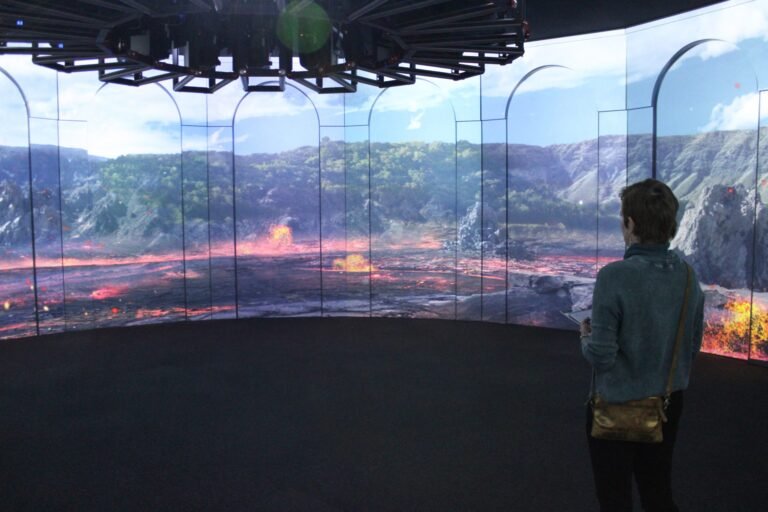Pompeii was an advanced city.
In 79 A.D., the Roman city was a vast building site — cranes and scaffolding were everywhere as the Romans rebuilt homes and public buildings rattled by an earthquake years earlier.
Residents of the idyllic spot near modern day Naples enjoyed fertile soils and tended large garden sites; some families were involved in wine production. So advanced was the society, surgical operations weren’t rare, although medicinal herbs were the basis of health care. Pompeii’s citizens invented machines, instruments and other sophisticated devices to improve their lives.
All of that ended — over the course of two dark days. An eruption of Mount Vesuvius destroyed everything. No one survived. All that was left was art, artifacts and archaeological marvels.
Those surviving pieces — along with the re-creation of the drama and ruins of the ancient city brought to life through a 360-degree multimedia experience — are now on display at the Arlington Museum of Art. “Pompeii: The Immortal City,” which runs from March 30 to June 23 at 1200 Ballpark Way, is the headline exhibition for the museum’s grand opening in the city’s Entertainment District.
The relocated Arlington Museum of Art takes over 40,000 square feet inside the city’s Esports Stadium and Expo Center. Its previous location in downtown Arlington was about 5,500 square feet.
“Pompeii is something that we’ve thought about for a very long time, and we just were not able to do it in the other building — the size, scale, power that’s needed, it just wasn’t feasible,” said Kendall Quirk, the museum’s registrar and director of exhibitions.
If you go
- What: The Arlington Museum of Art presents “Pompeii: The Immortal City” and “One Point Five Degrees” for its grand reopening.
- When: March 30-June 23
- Tuesday-Saturday: 10 a.m.-5 p.m.
- Sunday: 1-5 p.m.
- Where: 1200 Ballpark Way
- Price:
- “Pompeii: The Immortal City”: $23; $8 for children ages 2-12 and military with valid ID; $12 for groups of 10+
- “One Point Five Degrees”: $37; $12 for children ages 2 -12 and military with valid ID; $15 for groups of 10+
- Both shows: $50; $15 for children ages 2-12 and military with valid ID; $20 for groups of 10+
Visit here for more details.
Mayor Jim Ross was a part of the team that went to Pompeii to close the deal and bring the exhibition to Arlington. The museum could never have obtained this exhibit without the new space, he said.
Having experienced “Pompeii: The Immortal Story” in the museum’s new home, Ross said the exhibition tells a “phenomenal” story for audiences in the North Texas area to enjoy.
“There’s going to be people coming from all over the country to see this exhibit,” he said.

“One Point Five Degrees” exhibition
Alongside “Pompeii: The Immortal City,” the museum will also present the digital exhibition “One Point Five Degrees” in its immersive galleries.
Arlington Museum of Art collaborates with Fort Worth-based artist Adam Fung and Canadian artist Sabrina Ratté for the project.
“The theme overall in the whole building is the earth and global warming and natural disasters with Pompeii,” Quirk said. “Then these two pieces really talk about how the earth is changing, so that’s kind of the overview of why we did these two exhibitions.”
The Arlington Tomorrow Foundation is the presenting sponsor for “Pompeii: The Immortal City.”
The exhibition “marks the official opening of the ‘reimagined AMA’ as the latest, exciting addition to our Entertainment District,” said Carolyn Mentesana, executive director of the Arlington Tomorrow Foundation, in a press release.
The exhibition has made its rounds, from Brussels, Belgium, to Jersey City, New Jersey. The show’s curator is Giovanni Di Pasquale, deputy science director of Museo Galileo in Florence, Italy, whose background shines through the gems of the collection. They’re not the sensational clips of magma blasts and destruction. Instead, they are small artifacts: the small amphora, the brazier and the medical box.

More than 100 artifacts are included in the exhibition, Quirk said. Together with replicas and machines to create interactive experiences of the destruction, “Pompeii: The Immortal City” fills the museum’s entire 13,000-square-foot traditional gallery space — more than twice the size of the entire former location.
“The volcanic eruption which destroyed the Roman city of Pompeii in the year 79 was a catastrophe for its inhabitants, but a great opportunity for us,” the exhibition’s introduction reads. “It actually makes it possible for us to explore the daily life of these men and women, as if they still lived alongside us, nearly 2,000 years later.”
Maybe that concept of exploring daily life explained why some of the items were more common. Most items were labeled with “Please don’t touch” but were not locked in cases.
They highlighted something that videos of destruction couldn’t fully demonstrate.
Before Pompeii was immortal, the city was alive.
Dang Le is a reporting fellow for the Fort Worth Report. Contact him at dang.le@fortworthreport.org or @DangHLe. At the Fort Worth Report, news decisions are made independently of our board members and financial supporters. Read more about our editorial independence policy here.





